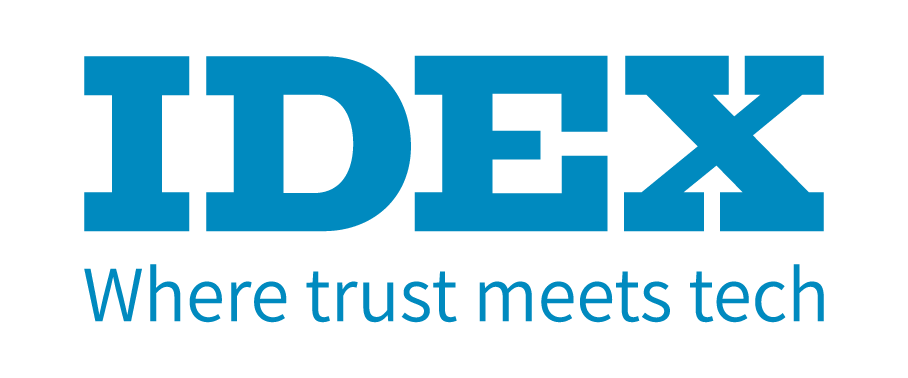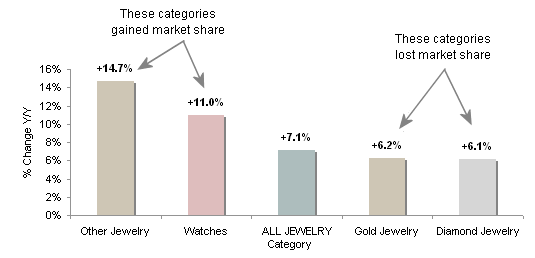IDEX Online Research: Gold Jewelry Demand in 2006 - “He Said, She Said”
May 31, 07
The dilemma: On one hand, the World Gold Council says gold jewelry sales rose by over 6 percent in the U.S. in 2006, and everything is basically peachy-keen. On the other hand, the research firm GFMS, writing for the World Gold Council, paints what appears to be a depressing picture of gold consumption for jewelry in 2006.
Who is right? What is going on here?
The quick answer is this: it depends on who is talking and what you are measuring.
- If you are a gold miner and fabricator, your unit volume (tons of gold sold) fell in 2006. That sounds bad, until you understand that virtually every gold mining and fabricating company reported higher revenues in 2006. Even better, costs did not rise nearly as much as revenues, so profits were up. Most media reports did not focus on the financial implications of higher gold prices on miners and suppliers. In short, higher gold prices were good news for gold miners and fabricators.
- If you are a jewelry retailer in America, your gold jewelry sales – as measured by dollars through the cash register, total pieces sold, and average ticket – rose in 2006. But, media reports seemed to focus on hand-wringing jewelers who lamented that higher gold prices were going to hurt their business. That obviously didn’t happen. Again, higher gold prices were good news for retail jewelers in the U.S. market.
- Only those in the middle of the pipeline may have suffered. Suppliers who purchased gold at high prices, but could not fully pass on those higher prices to their customers, experienced reduced profits. There is nothing unusual about this. The diamond pipeline is suffering from the same malaise. In many other retail categories, suppliers “in the middle” have gone out of business, and the distribution pipeline has both shortened and become much more efficient. That will eventually happen in the gold pipeline.
Research Review & Analysis
IDEX Online Research spent significant time analyzing and reconciling gold jewelry sales figures for 2006. Our viewpoint has always been from the consumer end of the pipeline. Without consumers, there would be no pipeline, nor would there be miners, fabricators, suppliers, and others along the distribution channel. From our viewpoint, the consumer is the final arbitrator, and is therefore the most important link in the gold jewelry pipeline.
As a result of our review and analysis of the gold jewelry market, we have prepared a seven-part series on the gold jewelry market for 2006. The seven parts include the following:
- Introduction – Gold Jewelry in 2006: “He said . . . she said” – This chapter reviews and reconciles the apparently conflicting – and sometimes just plain wrong – facts about the U.S. consumer market in 2006.
- Americans Love Gold Jewelry – U.S. consumers bought more gold jewelry, whether you measure it by average ticket, total pieces, or total consumption in dollars.
- Gold Average Ticket Moves Up – After falling for more than a decade, the average ticket for a piece of gold jewelry rose modestly in the American market in 2006.
- Specialty Jewelers at the End of the Rainbow – In America, nearly half of all gold jewelry is sold by specialty jewelers.
- Gold Bridal Jewelry: A Golden Opportunity of Jewelers – Gold wedding rings generate by far the highest average ticket of all gold jewelry categories. Specialty jewelers’ average ticket for gold wedding rings is especially high.
- Department Stores Generate Highest Average Ticket for All Gold Jewelry – They may be perceived as a retailing dinosaur, but shoppers’ average ticket for gold jewelry purchased in a department store is highest of all retail outlets.
- Gold Jewelry: A Seasonal Purchase – Gold jewelry sales are even more seasonal than “all jewelry”. About 45 percent of all gold jewelry (by value) is sold in the fourth quarter Holiday Season, well ahead of the 38 percent of all jewelry (by value) that is sold in the fourth quarter.
View from Fabrication
From the viewpoint of gold fabricators and suppliers, 2006 sounds like it was a poor year. Here are the facts, as reported by GFMS, the research organization which tracks precious metals in global markets, in various publications:
- Total global gold fabrication fell by 11 percent in 2006.
- Jewelry off-take fell by more than 21 percent.
- Weak jewelry imports by important consuming countries like the U.S. had a detrimental impact on gold fabricators in producer countries like Italy.
U.S. Market - 2006 Sales Growth Trends
By Jewelry Category
Source: U.S. Dept of Commerce, DIC, WGC, LGI, IDEX Online
- There is a relationship between the price of gold and gold jewelry consumption, but it varies by region of the world, depending on many different factors.
- Lack of credit line expansion kept dealers from replenishing their stock with higher cost inventory. This put a damper on the availability of gold jewelry.
- Fabricators shifted to hollow and thinner items with lower karat weight.
- Suppliers added other materials, often of little intrinsic value such as pave colored stones, to try to create the perception of value.
- Suppliers created brands to try to create the perception of value.
- In the U.S., GMFS noted that “the weakness in retail sales of jewellery had a detrimental effect on . . .” demand. Unfortunately, they got it wrong: jewelry sales in the U.S. rose by a robust 7.1 percent in 2006, one of the largest gains in the past ten years. Among specialty jewelers, sales rose by a solid 6.4 percent. Gold jewelry sales rose by a strong 6.1 percent, the third strongest in the past decade; this was in line with the gain 6.1 percent for diamond jewelry.
GFMS, in an apparent attempt to try to make the gold industry feel good about a dismal year, said, “Industry data shows that gold, along with diamonds, gained market share at the expense of other forms of jewellery.” Again, this is incorrect information. The graph below illustrates that both diamond and gold jewelry lost market share while other forms of jewelry actually gained market share in the U.S.
After reading this list, it is easy to see why gold fabricators and suppliers saw the proverbial glass as “half empty” in 2006.
IDEX Online Research pulled the financial reports of some of the most important global gold producers. Our findings were consistent: every one of those companies reported higher sales and significantly greater profits. In other words, they cried all the way to the bank.
View from Retail
Statistics from the World Gold Council painted a rosy picture of the gold jewelry market for retailers and shoppers in America. Here are a few facts as well as some conclusions by IDEX Online Research about the gold jewelry market at retail in the U.S.
- Gold jewelry sales rose by a robust 6.1 percent. While this was below total industry sales gain, it meant that jewelry retailers can attribute a significant portion their 2006 sales gain – and dollars through their cash registers – to gold jewelry.
- The average ticket for gold jewelry rose by about 1 percent in 2006 to $76.70.
- The total number of gold jewelry units rose by about 5 percent in 2006. In other words, jewelers sold 5 percent more pieces of gold jewelry in 2006 than in 2006. Using averages (something that is often dangerous), the typical U.S. jeweler sold just over 2,500 pieces of gold jewelry in 2006, based on World Gold Council data.
- U.S. shoppers are willing to spend about $75-80 on a piece of gold jewelry. They care more about keeping within their budget than they care about the intrinsic value of the gold in gold jewelry. As the retail price of gold jewelry has risen in response to higher gold costs, shoppers simply “bought cheaper”. (Consumers in other regions of the world do care about the intrinsic value of gold in their jewelry, but this appears to be unimportant to most American consumers.)
- Gold jewelry is largely a fashion accessory for most U.S. consumers. Unlike some other regions of the world – India, for example, where gold jewelry is perceived as a store of value – U.S. consumers look at gold jewelry primarily as fashion.
- Due to high markup in gold jewelry, GFMS noted that retailers (and perhaps others in the supply chain) did not pass along the full amount of 2006’s gold price increases to their customers.
The Bottom Line
Here’s the way we see it:
- If you were a gold jewelry retailer in 2006, your sales were up solidly, though there may have been some profit pressure.
- If you were a gold miner in 2006, your production fell, but your revenues and profits rose.
- If you were in the middle of the gold pipeline, you may have suffered. Sales were up, but you had no buffer to protect profits. Your gold cost more, but you probably could not pass along those costs to your retail customers. Once again, this is a characteristic of many of the distribution pipelines in the jewelry industry – too many hands touch the goods on the way from the mine to the market. The ultimate answer: wholesalers and suppliers will be forced out of business, and the pipeline will shorten significantly, just as it has in most other retail categories.
- GFMS said it this way: “For 2006 (in the U.S. market), demand fell 12 percent in tonnage terms, the equivalent to a 20 percent increase in dollar terms. That roughly squares with the 35 percent increase in the average price of gold in 2006 over 2005.
- If you are counting dollars, you had a good year. If you are counting tonnage, you had a weak year. What’s most important? Cash, cash, cash. And it was up, up, up.
Next week: Americans Love Gold Jewelry.